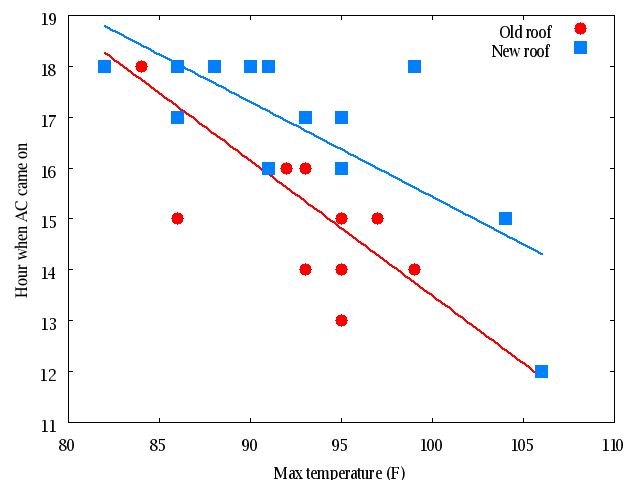Radiant barrier plywood works!
October 13th, 2012 at 10:07 am (Engineering)
 When the contractor tore off my old shingles to replace my roof, they found that underneath were the original wooden shingles. California code no longer permits wooden shingles (fire hazard!), so these had to come off, too. But the wooden shingles were laid on slats with 6-inch gaps between them, so that meant I also needed a layer of plywood put down to support the new shingles. California code (at least in my town) also requires that this plywood be radiant barrier plywood, which is plywood with a foil backing on one side. You lay the plywood shiny-side *down*, and then in theory it reflects heat back up through the shingles, reducing what gets into the attic.
When the contractor tore off my old shingles to replace my roof, they found that underneath were the original wooden shingles. California code no longer permits wooden shingles (fire hazard!), so these had to come off, too. But the wooden shingles were laid on slats with 6-inch gaps between them, so that meant I also needed a layer of plywood put down to support the new shingles. California code (at least in my town) also requires that this plywood be radiant barrier plywood, which is plywood with a foil backing on one side. You lay the plywood shiny-side *down*, and then in theory it reflects heat back up through the shingles, reducing what gets into the attic.
My contractor was skeptical as to whether this plywood would really make a difference, but agreed to install it per code. (It is also not much more expensive than regular plywood.) Naturally, I wanted to test it empirically. So I collected some data.
My SCE smart meter reports the maximum daily temperature and my energy consumption per hour online. I have my thermostat set to 85 F during the day, and I can track when the air conditioner came on by looking for a spike in energy consumption. I defined the hour at which the A/C came on (i.e., internal house temperature reached 85 F) as an hourly consumption greater than 1 kWh. In the following plot, I show the time when the A/C came on as a function of maximum outside temperature. Higher values are better (later in the day). And sure enough, the new roof out-performs the old one.

Note that I used a linear fit here, but that probably isn’t appropriate at higher temperatures. Also, the times are capped at 18:00 (6 p.m.) as that’s when my thermostat switches to “evening” mode and tries to drive the temperature down to 82 F instead of 85 F.
Caveats: this is the result of the roof as a package, not just the plywood. I also had attic vents installed that probably help keep the attic cooler. It’s also possible that I’m seeing more of an effect than others might, because as far as I can tell my house has no insulation in the ceiling (California!). Thus, the living space and attic are more coupled than they would be with insulation.
Overall, however, I’m pleased to see that my new roof is performing so well! The only down side of the radiant barrier plywood is that it came with an intense chemical smell that soaked down through the attic into the living space and, on hot days, was so bad that I had to turn off the A/C so I could open the windows and tough out the heat just to be able to breathe. I couldn’t access the attic at all. Happily, after about three weeks, this finally faded away. The manufacturer claims this is due to the glue in the plywood.